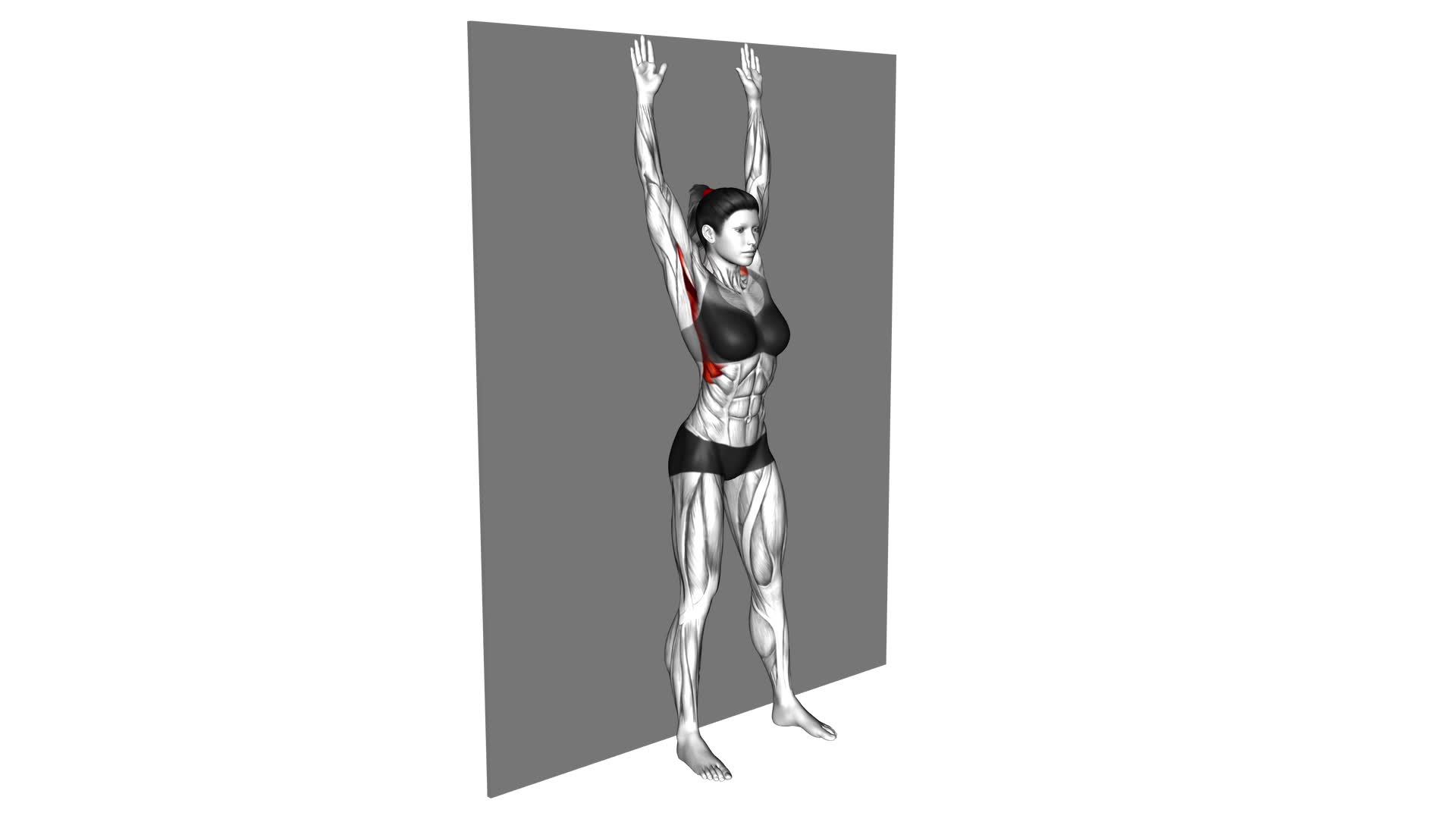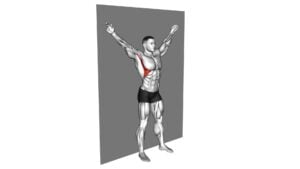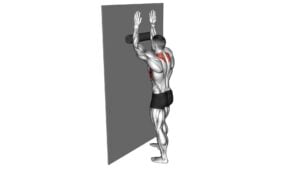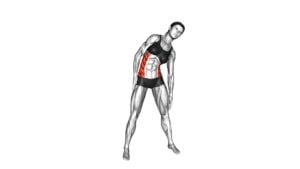Scapular Slide Back to Wall (female) – Video Exercise Guide & Tips

Are you looking for a quick and effective exercise to strengthen your scapular muscles? Look no further than the Scapular Slide Back to Wall exercise.
Watch This Exercise Video
This video guide will show you the proper set-up and body positioning, as well as provide step-by-step instructions for performing the exercise.
Avoid common mistakes and maximize the effectiveness of this exercise with helpful tips.
Get ready to level up your training with variations and progressions for advanced training.
Key Takeaways
- The Scapular Slide Back to Wall exercise improves posture and shoulder stability.
- It targets muscles in the upper back, specifically the rhomboids and lower traps.
- Proper form and body positioning are important to maximize the effectiveness of the exercise and prevent strain or injury.
- There are variations and progressions of the exercise that can be used to increase difficulty and continue improving scapular function and upper body strength.
Benefits of the Scapular Slide Back to Wall Exercise
One benefit of performing the Scapular Slide Back to Wall exercise is that it helps improve your posture and shoulder stability. This exercise specifically targets the muscles in your upper back, which play a crucial role in maintaining good posture and shoulder mobility. By strengthening these muscles, you can prevent common issues such as rounded shoulders and forward head posture.
The Scapular Slide Back to Wall exercise involves standing with your back against a wall, elbows bent at 90 degrees, and your forearms resting against the wall. From this starting position, you slide your forearms up and down the wall, focusing on keeping your shoulder blades engaged and maintaining contact with the wall at all times. This movement activates the muscles in your upper back, particularly the rhomboids and lower traps, which are responsible for retracting and depressing the scapulae.
Regularly performing this exercise can help improve your shoulder mobility by increasing the strength and stability of the muscles surrounding the shoulder joint. It also helps correct muscle imbalances that may be causing poor posture. Incorporating the Scapular Slide Back to Wall exercise into your routine can lead to improved overall posture and shoulder function.
Proper Set-up and Body Positioning
To ensure optimal alignment for proper posture during the Scapular Slide Back to Wall exercise, it's essential to set up and position your body correctly.
This will allow you to target the correct muscles and avoid common positioning mistakes.
Optimal Alignment for Posture
To achieve optimal alignment for posture, make sure you set up your body position correctly. Begin by standing with your back against a wall, making sure your feet are shoulder-width apart. Engage your core muscles and gently pull your shoulder blades back and down. This position will help align your spine and promote good posture.
Keep your head in a neutral position, with your chin slightly tucked in. Ensure that your shoulders are relaxed and not hunched forward. Proper alignment is crucial for posture correction and can help alleviate muscle imbalances and reduce the risk of injury.
Now that you understand the importance of optimal alignment, let's move on to correcting common positioning mistakes.
Correcting Common Positioning Mistakes
Ensure correct body positioning by adjusting your setup and engaging your core muscles. It's important to address common misconceptions and emphasize the importance of proper form when performing the Scapular Slide Back to Wall exercise.
One common misconception is that you should arch your back or push your chest forward during the exercise. However, this can lead to incorrect alignment and ineffective results. Instead, focus on maintaining a neutral spine and keeping your core engaged throughout the movement.
Proper form is essential for targeting the correct muscles and avoiding strain or injury. By correcting your positioning and maintaining proper form, you can maximize the benefits of the exercise and achieve optimal results.
Now, let's move on to the step-by-step guide for performing the Scapular Slide Back to Wall exercise.
Step-by-Step Guide for Performing the Exercise
Start by standing with your back against the wall. Follow these step-by-step instructions and technique tips to perform the Scapular Slide Back to Wall exercise correctly:
- Position yourself: Stand with your feet hip-width apart, approximately 6 inches away from the wall. Keep your spine straight and your shoulders relaxed.
- Place your hands on the wall: Extend your arms forward and place your palms flat against the wall, shoulder-width apart.
- Engage your core: Activate your abdominal muscles by pulling your belly button towards your spine.
- Slide your shoulder blades: Slowly slide your shoulder blades down and back towards the wall while maintaining contact with the wall at all times. Keep your elbows slightly bent throughout the movement.
This exercise helps improve scapular stability and posture by strengthening the muscles that support the shoulder blades. By following these instructions and focusing on the technique, you can maximize the benefits of the Scapular Slide Back to Wall exercise.
Remember to start with light resistance and gradually increase as you become more comfortable with the movement.
Common Mistakes to Avoid
When performing the Scapular Slide Back to Wall exercise, it's important to be aware of common mistakes that can hinder your progress.
One common mistake is poor posture correction, such as allowing your shoulders to hunch forward instead of pulling them back.
Another mistake to avoid isn't completing the full range of motion, which can limit the effectiveness of the exercise.
Lastly, lack of shoulder stability can also hinder your ability to properly perform the exercise, so focus on engaging your shoulder muscles throughout the movement.
Poor Posture Correction
Correct your poor posture by focusing on proper alignment and avoiding common mistakes. Here are four key mistakes to avoid when working on improving alignment and strengthening muscles:
- Rounded Shoulders: Avoid slouching or hunching forward, as this can lead to rounded shoulders. Instead, consciously pull your shoulder blades back and down to maintain a neutral position.
- Forward Head Posture: Be mindful of your head position and avoid jutting it forward. Keep your head aligned with your spine, as if you were holding an imaginary book on top of it.
- Arching Lower Back: Resist the temptation to arch your lower back excessively. Engage your core muscles and maintain a slight pelvic tilt to achieve a neutral spine position.
- Slouching While Sitting: Sitting for prolonged periods can contribute to poor posture. Sit up straight, with your back aligned against the chair, and use a lumbar support if needed.
By avoiding these common mistakes and focusing on proper alignment, you can greatly improve your posture and prevent discomfort.
Now, let's move on to the next section about incomplete range of motion.
Incomplete Range of Motion
To improve your range of motion and avoid common mistakes, it's important to focus on completing each exercise with proper form and technique.
When performing the Scapular Slide Back to Wall exercise, it's crucial to ensure that you're achieving the full range of motion.
Many people make the mistake of stopping the movement before reaching the end position, limiting the benefits of the exercise.
By fully extending your arms overhead and sliding your scapulae against the wall, you aren't only improving flexibility in your shoulder joints, but also strengthening the scapular muscles.
It's essential to push yourself to complete the entire range of motion, as this will maximize the effectiveness of the exercise and contribute to better posture and shoulder stability.
Lack of Shoulder Stability
To avoid a lack of shoulder stability during the Scapular Slide Back to Wall exercise, ensure that you engage your scapular muscles and maintain proper form throughout the movement. Shoulder stability is crucial for preventing injuries and maximizing the effectiveness of the exercise.
Here are some common mistakes to avoid:
- Allowing your shoulders to shrug up towards your ears: Keep your shoulders relaxed and pulled down away from your ears.
- Failing to engage your core: Activate your core muscles to provide stability and support for your shoulders.
- Arching your lower back: Maintain a neutral spine position to avoid placing unnecessary stress on your shoulders.
- Rushing through the exercise: Take your time and focus on performing each rep with control and precision.
Tips for Maximizing the Effectiveness of the Exercise
To maximize the effectiveness of the exercise, try using a slightly wider hand placement on the wall. This will engage your shoulder and scapular muscles more effectively, maximizing your results. By placing your hands slightly wider than shoulder-width apart, you'll increase the range of motion and challenge your muscles in different ways.
In addition to adjusting your hand placement, it's crucial to focus on maintaining proper form throughout the exercise. This will ensure that you're targeting the correct muscles and avoiding any form correction issues. Start by standing with your back against the wall, and your feet about hip-width apart. Place your hands on the wall at shoulder height, slightly wider than shoulder-width apart. Keep your elbows slightly bent and your shoulder blades pulled back and down.
As you slide your arms up the wall, focus on engaging your scapular muscles and keeping your core stable. Avoid arching your back or shrugging your shoulders. Maintain a slow and controlled movement, ensuring that you feel the muscles in your upper back and shoulders working. If you find it difficult to maintain proper form, start with smaller movements and gradually increase your range of motion as you build strength and stability.
Variations and Progressions for Advanced Training
Explore advanced variations and progressions to take your Scapular Slide Back to Wall exercise to the next level. These variations and progressions will challenge your strength, stability, and control, allowing you to continue improving your scapular function and overall upper body strength.
Here are four advanced variations and progressions to try:
- Single-leg Scapular Slide Back to Wall: Lift one leg off the ground while performing the exercise to increase the demand on your core and hip stability.
- Weighted Scapular Slide Back to Wall: Hold a dumbbell or kettlebell in your hands while sliding your scapulae down the wall. This added resistance will help you build even more strength in your upper back and shoulders.
- Scapular Push-ups: Start in the Scapular Slide Back to Wall position, then push yourself away from the wall by protracting your shoulder blades. This exercise will challenge your scapular control and strengthen your chest and triceps.
- Scapular Slides with Resistance Bands: Attach a resistance band around your wrists and perform the Scapular Slide Back to Wall exercise. The band will provide constant resistance, making the exercise more challenging and effective.
Frequently Asked Questions
Can I Perform the Scapular Slide Back to Wall Exercise if I Have a Shoulder Injury?
If you have a shoulder injury, it's important to modify exercises to avoid further damage. The scapular slide back to wall exercise may not be suitable for you in this situation.
However, there are alternative exercises that can help with shoulder injury recovery. It's best to consult with a healthcare professional or a physical therapist who can provide you with specific modifications and recommend exercises that are safe and beneficial for your shoulder injury.
How Many Repetitions and Sets Should I Do for This Exercise?
For the Scapular Slide Back to Wall exercise, it's important to consider the number of repetitions and sets you should perform.
Without considering the specific context of the exercise video guide, it's generally recommended to start with 2-3 sets of 10-15 repetitions.
However, the number of repetitions and sets can vary depending on factors such as your fitness level and any modifications needed for a shoulder injury.
It's always best to consult with a qualified healthcare professional for personalized guidance.
Can I Use a Resistance Band to Make the Exercise More Challenging?
To make the Scapular Slide Back to Wall exercise more challenging, you can definitely incorporate resistance bands. Resistance band variations can help engage your muscles even more and provide additional resistance. By attaching the resistance band to a stable object and holding the other end, you can create tension throughout the movement. This will require your muscles to work harder, making the exercise more challenging and effective.
Alternatively, you can also explore alternative exercises using resistance bands to target similar muscle groups.
Is It Normal to Feel a Burning Sensation in My Upper Back While Performing the Scapular Slide Back to Wall Exercise?
Feeling a burning sensation in your upper back during the scapular slide back to wall exercise isn't unusual. It could be a sign of muscle fatigue or strain. Make sure you're maintaining proper form and not overloading the exercise.
If the burning sensation persists or becomes painful, it's advisable to consult a healthcare professional. Remember to listen to your body and modify the exercise if needed to prevent any further discomfort or injury.
Can This Exercise Help Improve My Posture?
Improving your posture is a key benefit of the scapular slide back to wall exercise. By performing this exercise, you can strengthen the muscles in your upper back, shoulders, and neck, which helps to align your spine and improve your overall posture.
The scapular slide back to wall exercise specifically targets the muscles responsible for retracting and stabilizing your shoulder blades. This exercise can be an effective way to correct rounded shoulders and promote better alignment in your upper body.
Conclusion
In conclusion, the scapular slide back to wall exercise is a highly effective way to improve scapular stability and shoulder strength.
By following the proper set-up and body positioning, and avoiding common mistakes, you can maximize the effectiveness of this exercise.
Additionally, there are variations and progressions available for advanced training.
Incorporating this exercise into your routine can lead to improved overall shoulder health and performance.

Author
Years ago, the spark of my life’s passion ignited in my mind the moment I stepped into the local gym for the first time. The inaugural bead of perspiration, the initial endeavor, the very first surge of endorphins, and a sense of pride that washed over me post-workout marked the beginning of my deep-seated interest in strength sports, fitness, and sports nutrition. This very curiosity blossomed rapidly into a profound fascination, propelling me to earn a Master’s degree in Physical Education from the Academy of Physical Education in Krakow, followed by a Sports Manager diploma from the Jagiellonian University. My journey of growth led me to gain more specialized qualifications, such as being a certified personal trainer with a focus on sports dietetics, a lifeguard, and an instructor for wellness and corrective gymnastics. Theoretical knowledge paired seamlessly with practical experience, reinforcing my belief that the transformation of individuals under my guidance was also a reflection of my personal growth. This belief holds true even today. Each day, I strive to push the boundaries and explore new realms. These realms gently elevate me to greater heights. The unique combination of passion for my field and the continuous quest for growth fuels my drive to break new ground.







